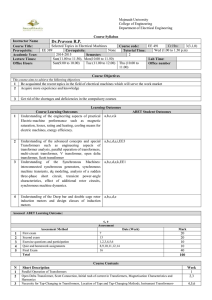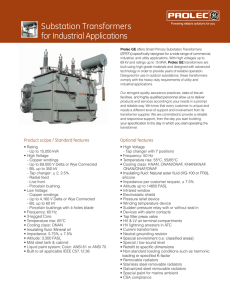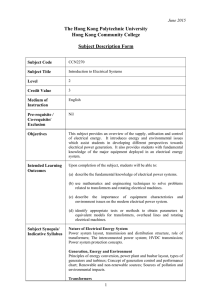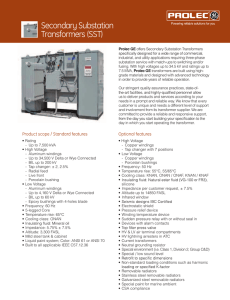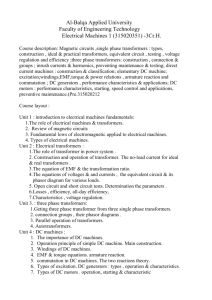Course No. Course Name L-T-P -Credits Year of Introduction EE205
advertisement
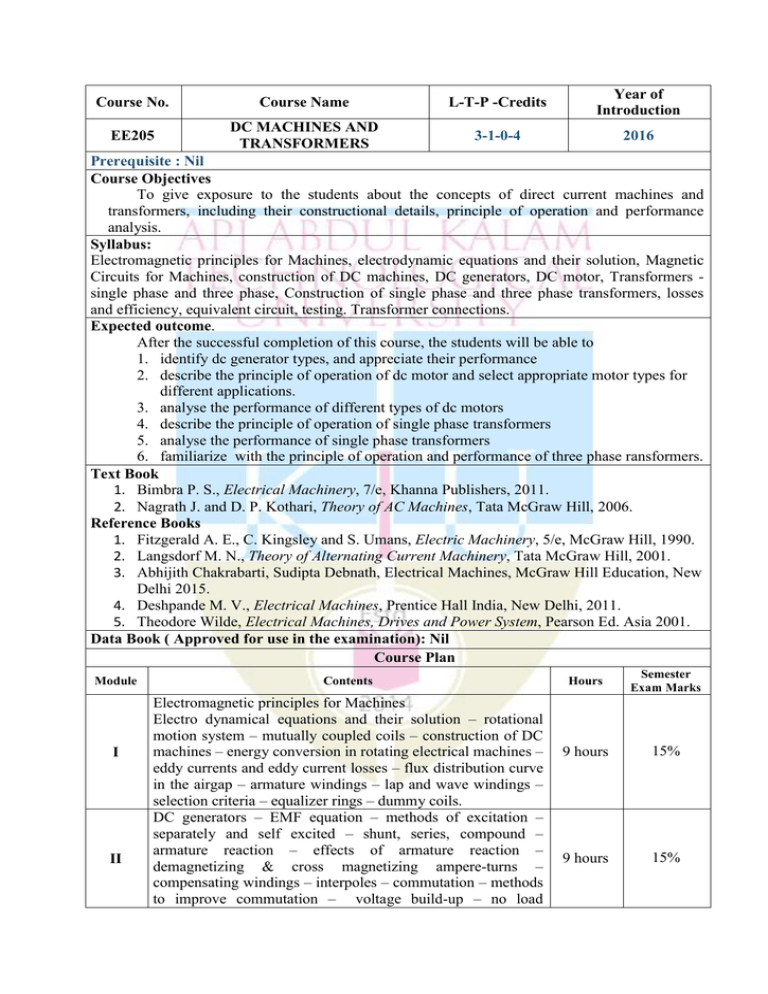
Course No. Course Name L-T-P -Credits Year of Introduction EE205 DC MACHINES AND TRANSFORMERS 3-1-0-4 2016 Prerequisite : Nil Course Objectives To give exposure to the students about the concepts of direct current machines and transformers, including their constructional details, principle of operation and performance analysis. Syllabus: Electromagnetic principles for Machines, electrodynamic equations and their solution, Magnetic Circuits for Machines, construction of DC machines, DC generators, DC motor, Transformers single phase and three phase, Construction of single phase and three phase transformers, losses and efficiency, equivalent circuit, testing. Transformer connections. Expected outcome. After the successful completion of this course, the students will be able to 1. identify dc generator types, and appreciate their performance 2. describe the principle of operation of dc motor and select appropriate motor types for different applications. 3. analyse the performance of different types of dc motors 4. describe the principle of operation of single phase transformers 5. analyse the performance of single phase transformers 6. familiarize with the principle of operation and performance of three phase ransformers. Text Book 1. Bimbra P. S., Electrical Machinery, 7/e, Khanna Publishers, 2011. 2. Nagrath J. and D. P. Kothari, Theory of AC Machines, Tata McGraw Hill, 2006. Reference Books 1. Fitzgerald A. E., C. Kingsley and S. Umans, Electric Machinery, 5/e, McGraw Hill, 1990. 2. Langsdorf M. N., Theory of Alternating Current Machinery, Tata McGraw Hill, 2001. 3. Abhijith Chakrabarti, Sudipta Debnath, Electrical Machines, McGraw Hill Education, New Delhi 2015. 4. Deshpande M. V., Electrical Machines, Prentice Hall India, New Delhi, 2011. 5. Theodore Wilde, Electrical Machines, Drives and Power System, Pearson Ed. Asia 2001. Data Book ( Approved for use in the examination): Nil Course Plan Module I II Contents Electromagnetic principles for Machines Electro dynamical equations and their solution – rotational motion system – mutually coupled coils – construction of DC machines – energy conversion in rotating electrical machines – eddy currents and eddy current losses – flux distribution curve in the airgap – armature windings – lap and wave windings – selection criteria – equalizer rings – dummy coils. DC generators – EMF equation – methods of excitation – separately and self excited – shunt, series, compound – armature reaction – effects of armature reaction – demagnetizing & cross magnetizing ampere-turns – compensating windings – interpoles – commutation – methods to improve commutation – voltage build-up – no load Hours Semester Exam Marks 9 hours 15% 9 hours 15% III IV V VI characteristics – load characteristics – losses and efficiency – power flow diagram – parallel operation – applications of dc generators. FIRST INTERNAL EXAMINATION DC motor – principle of operation – back emf – classification – torque equation – losses and efficiency – power flow diagram – performance characteristics of shunt, series and compound motors – starting of dc motors – necessity and types of starters – speed control – methods of speed control – testing – Swinburne’s test – Hopkinson’s test – separation of losses – retardation test – applications of dc motors. Transformers – principle of operation – types and construction, core type and shell type construction, dry type transformers, cooling of transformers – ideal transformer – transformation ratio – dot convention – polarity test – practical transformer – kVA rating – equivalent circuit – phasor diagram. SECOND INTERNAL EXAMINATION Transformer losses and efficiency – voltage regulation – OC & SC test – Sumpner’s test – all day efficiency Autotransformer – saving of copper – current rating and kVA rating of autotransformers, parallel operation of single phase transformers, necessary and desirable conditions of parallel operation, on load and off load tap changers. 3-phase transformer – 3-phase transformer connections – ∆-∆, Y-Υ , ∆-Y , Y-∆, V-V – vector groupings Yy0, Dd0, Yd1, Yd11, Dy1, Dy11 – Scott connection – three winding transformer – tertiary winding – percentage and per unit impedance – parallel operation of three phase transformers. END SEMESTER EXAM 9 hours 15% 9 hours 15% 9 hours 20% 9 hours 20% QUESTION PAPER PATTERN (End semester exam) Part A: 8 questions. One question from each module of Module I - IV; and two each from Module V & VI. Student has to answer all questions. (8 x5)=40 Part B: 3 questions uniformly covering modules I&II Student has to answer any 2 questions: (2 x 10) =20 Part C: 3 questions uniformly covering modules III&IV Student has to answer any 2 questions: (2 x 10) =20 Part D: 3 questions uniformly covering modules V&VI Student has to answer any 2 questions: (2 x 10) =20 Note: Each question can have maximum of 4 sub questions, if needed.
